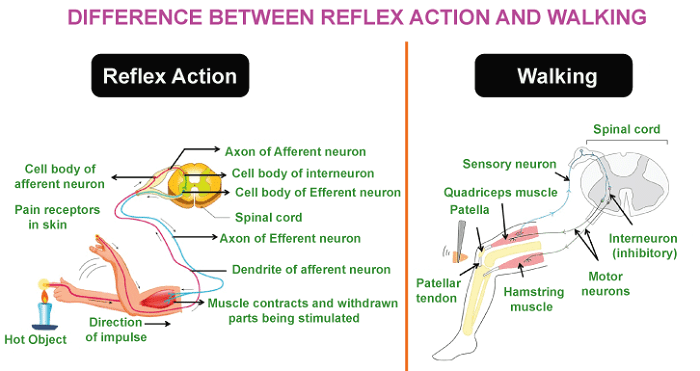Difference Between Reflex Action and WalkingIntroductionHave you tried to understand the differences between a reflex action and walking? If not, this article will assist you in learning everything. If you want to improve your understanding of how the brain and body of a person work, you must be able to distinguish between a reflex action and Walking. A reflex action is an automatic, swift movement frequently performed in reaction to stimuli. Walking is a voluntary activity requiring your upper and lower bodies to move synchronously. When you walk, your feet perform rhythmic movement while your knees, hips, and spine move as a single unit. Reflex action and Walking are discussed in-depth in this article. It also clarifies the muscles used in both cases. 
What is a Reflex Action?In the human body, there are many kinds of brain activity, but only one straightforward kind: reflex action. This phrase was first used in biology in the nineteenth century by an English neurologist, Marshall Hall. Any unexpected or involuntary behavior by our body in response to stimuli is a reflex action (sudden event giving rise to an action). When speaking about an activity that lacks conscious participation, the term "reflex action" is used. The reflex arc is a term used to describe the anatomical path of a reflex. An afferent neuron and an efferent nerve are present in the reflex arc. Importance of a Reflex ActionA reflex action, however, is a quick reaction. This does not necessarily imply that it is undesirable. Reflex movements often keep us safe from difficult circumstances. An unconscious reaction is a reflex action. Therefore, a reflexive action is an automatic action. Reflex actions are not brain outputs. For instance, you immediately remove your hand from something hot after accidently touching it. Your body's fast response acts as your rescuer. What are a Few Examples of Reflex Action?
What are Voluntary Actions?Voluntary Actions are defined as intentional or purposeful actions or activities of any portion of our body. These acts happen to our decisions, as the name implies. With the aid of the cerebrum, the human body's voluntary movements are managed. In general, an action is referred to as being voluntary when it involves both thoughts and emotions. Voluntary behaviors are never conceived of as being unexpected; rather, they result from the nervous system's processing of thoughts. What Kinds of Actions are Voluntary?The following are some examples of voluntary actions:
Key Differences between Walking and Reflex ActionUnderstanding the important differences between voluntary and involuntary acts is crucial because they differ greatly.
The Following are the Key Distinctions Between Reflex Action and Walking in Tabular Form
ConclusionFor an in-depth understanding of the human body, it is crucial to study various brain activities. The terms "voluntary" and "involuntary" are fundamental and simple. Peripheral nerves carry both of these signals. The cerebrum, or forebrain, controls voluntary movements, whereas the hindbrain, or back brain, controls involuntary movements. Voluntary and Involuntary activity working patterns are significantly dissimilar. Walking is under our control as we can choose when to walk. In contrast, reflex action, a sort of involuntary activity, occurs immediately without our choice being involved and cannot be controlled. Walking is a sort of intentional behavior, unlike reflex action, which includes sneezing, coughing, and other involuntary bodily actions.
Next TopicDifference between
|
 For Videos Join Our Youtube Channel: Join Now
For Videos Join Our Youtube Channel: Join Now
Feedback
- Send your Feedback to [email protected]
Help Others, Please Share










